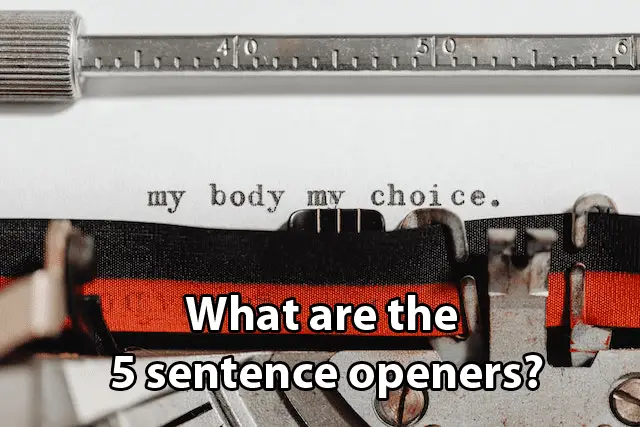
Sentence Openers: A Comprehensive Guide to Starting Your Writing
When it comes to writing, the way you start your sentences can have a significant impact on the overall quality of your work. This comprehensive guide aims to provide you with valuable insights and techniques to master the art of sentence openers and enhance your writing skills.
One key aspect of crafting engaging sentence openers is understanding the importance of variety. By exploring different approaches to starting your sentences, you can keep your readers engaged and prevent your writing from becoming predictable or monotonous. From using vivid descriptions to introducing intriguing anecdotes or thought-provoking questions, the possibilities are endless. This guide will equip you with the knowledge and strategies to break the monotony of traditional sentence openers and explore unique and innovative ways to captivate your readers right from the start. Whether you are writing fiction, non-fiction, or academic essays, the power of an enticing sentence opener cannot be underestimated. By perfecting this skill, you can create a strong first impression and set the stage for a captivating piece of writing.
How to Begin Sentences: Unlocking the Secrets to Effective Writing
Starting sentences is a crucial aspect of writing that often determines the effectiveness of our work. It sets the tone and grabs the reader’s attention right from the beginning. To truly unlock the secrets of effective writing, one must understand the various techniques and strategies for beginning sentences. Whether you’re writing an essay, a story, or even an email, carefully crafting your sentence openers can greatly enhance your communication.
One way to begin sentences is by using strong and impactful keywords. These are words that immediately capture the reader’s attention and convey the main idea or emotion you want to express. For example, using words like “unexpectedly,” “exhilarating,” or “profound” can instantly hook your reader and create a sense of intrigue. Additionally, incorporating action verbs such as “exploring,” “unleashing,” or “enhancing” can add a dynamic element to your writing, making it more engaging and memorable. By consciously selecting the right keywords, you can effectively convey your message and make a lasting impression on your audience.
Another effective technique to begin sentences is through the use of rhetorical questions. By posing a question at the start, you immediately involve the reader and encourage them to think critically about the topic at hand. For instance, asking “Have you ever wondered…” or “What if we could…” not only prompts the reader’s curiosity but also serves as a thought-provoking opener. Rhetorical questions can be particularly powerful in persuasive writing or when presenting a controversial idea. When used strategically, they evoke a sense of reflection and encourage readers to actively engage with your writing.
In summary, beginning sentences is an art that plays a significant role in effective writing. By utilizing strong keywords and employing rhetoric questions, you can capture your reader’s attention and create a compelling narrative. However, it’s important to remember that the art of starting sentences is not limited to these techniques alone. Every sentence offers an opportunity to experiment with different approaches, so don’t be afraid to think outside the box. In the next section, we will delve deeper into exploring various methods for sentence openers, empowering you to unleash your creativity and captivate your readers.
The Art of Crafting Engaging Sentence Openers: A Complete Guide
Sentence openers are the gateway to captivating your readers’ attention and drawing them into your writing. By crafting engaging sentence openers, you create a strong first impression and set the tone for the rest of your piece. Whether you’re writing a compelling narrative, an informative article, or a persuasive argument, mastering the art of sentence openers is essential for any writer.
One technique to consider when crafting engaging sentence openers is the use of descriptive language. By incorporating vivid adjectives, you can paint a picture in your readers’ minds, instantly captivating their attention. For example, instead of starting a sentence with “The dog ran,” you could begin with “The energetic golden retriever raced across the field, a blur of fur and excitement.” By choosing descriptive language that appeals to the senses, you create a more vivid and engaging experience for your readers. So, the next time you find yourself starting a sentence, remember the power of descriptive language to captivate your audience.
Mastering Sentence Openers: Techniques to Captivate Your Readers
Creating captivating sentence openers is an essential skill for any writer. It is the gateway to engaging readers and drawing them into your writing. By mastering the techniques of sentence openers, you can make a powerful impact right from the beginning.
One effective technique is the use of vivid imagery. By painting a vivid picture in the reader’s mind, you can instantly capture their attention. For example, “The sun slipped below the horizon, casting a warm golden glow over the serene lake” immediately sets the scene and creates a sense of tranquility. Such descriptive language creates a sensory experience, making the reader feel like they are right there in the moment.
Another technique is the element of surprise. By starting with an unexpected statement or a question, you can pique the reader’s curiosity and compel them to continue reading. For instance, “Have you ever wondered what lies hidden beneath the ocean’s depths? Brace yourself as we dive into a world unknown.” This opener immediately sparks intrigue and creates a sense of anticipation, urging the reader to uncover the mysteries that lie ahead.
Mastering sentence openers is an art that requires practice and experimentation. By utilizing techniques such as vivid imagery and elements of surprise, you can capture your readers’ attention from the very beginning. Stay tuned to discover more strategies and approaches that will enhance your writing skills and captivate your audience.
Exploring Different Approaches to Starting Sentences: A Writer’s Guide
One key element in effective writing is the ability to craft compelling sentence openers. By exploring different approaches to starting sentences, writers can enhance the impact of their writing and captivate their readers from the very beginning. This writer’s guide will delve into various techniques that can be employed to create engaging sentence openers.
One approach to consider is the use of descriptive language. By incorporating vivid adjectives and adverbs, writers can paint a vivid picture in the reader’s mind and set the tone for the entire piece. For example, instead of simply stating “The cat climbed the tree,” a writer could open with “Gingerly, the agile feline gracefully ascended the towering oak, its fur glistening under the vibrant sunshine.” This instantly creates a more vivid and engaging image, drawing the reader deeper into the story.
Unleashing Creativity: Innovative Ways to Open Your Sentences
As writers, we are constantly seeking ways to unleash our creativity and captivate our readers from the very first sentence. The way we open our sentences can make a significant impact on the overall tone and engagement of our writing. By exploring innovative ways to begin our sentences, we can infuse our writing with freshness and originality.
One creative approach to opening sentences is by using vivid imagery. By incorporating descriptive and sensory details, we can transport our readers into the scene and make them feel like they are a part of the story. For example, instead of starting a sentence with a mundane statement like “The sun was shining,” we can opt for a more engaging opener like “The sun, a fiery ball of golden radiance, bathed the world in its warm embrace.” This not only adds visual appeal but also sets the tone for a vivid and immersive reading experience. By utilizing this technique, we can transform ordinary sentences into captivating ones that leave a lasting impression on our audience.
Another innovative way to open sentences is by posing thought-provoking questions. By introducing a question at the beginning of a sentence, we instantly pique the curiosity of our readers and compel them to continue reading in search of the answer. For instance, instead of starting with a straightforward statement like “The protagonist was curious about the mysterious object,” we can begin with an intriguing question like “What secrets lay hidden within the enigmatic object that stirred the protagonist’s insatiable curiosity?” By employing this technique, we not only engage our readers but also create a sense of anticipation and suspense, enticing them to delve deeper into our writing.
Enhancing Your Writing Skills: Strategies for Effective Sentence Openers
Enhancing your writing skills involves adopting effective strategies for sentence openers. A well-crafted sentence opener sets the tone for your entire piece and captivates your readers from the very beginning. By incorporating different techniques and experimenting with various approaches, you can enhance the overall quality of your writing.
One strategy to consider is the use of vivid imagery. By painting a detailed picture in your readers’ minds, you can immediately capture their attention and create a compelling opening. Take, for example, the sentence opener, “The sun dipped below the horizon, casting a golden glow over the tranquil meadow.” This sentence not only sets a serene and picturesque scene but also immerses the reader in the sensory experience, making them eager to delve further into your writing.
From Traditional to Unique: Exploring Various Sentence Opening Techniques
When it comes to writing, the opening sentence plays a critical role in capturing the readers’ attention. It sets the tone for the entire piece and determines whether the audience will continue reading or lose interest. In this section, we will explore a range of sentence opening techniques that move away from traditional approaches and toward more unique and engaging styles.
One effective technique is to start with a rhetorical question. By posing a thought-provoking question, you immediately engage the readers’ curiosity and invite them to delve deeper into the subject matter. For instance, in an article about climate change, you could begin with, “What if the fate of our planet rests in our hands?” This technique not only grabs attention but also initiates a conversation and creates a sense of urgency in the readers’ minds.
Another approach is to start with a vivid description or an anecdote. By painting a vivid picture or sharing a personal story, you immediately draw the readers into the narrative and make them emotionally connect with the content. For example, instead of simply stating, “The city was flooded,” you could begin with, “As the rain poured mercilessly, the city transformed into a sprawling waterworld, engulfing houses and streets alike.” This technique allows the readers to visualize the scene and feel more invested in the story from the very first sentence.
By exploring various sentence opening techniques, writers can move away from conventional approaches and infuse their work with creativity and engagement. These techniques, such as using rhetorical questions or vibrant descriptions, have the power to captivate readers and create a lasting impact. So, let’s dive deeper into these techniques and unlock the potential to engage our audience right from the start.
Breaking the Monotony: Fresh Ideas for Starting Sentences
Breaking the Monotony: Fresh Ideas for Starting Sentences
When it comes to writing, one of the challenges that many writers face is breaking the monotony of their sentence openers. It’s all too easy to fall into the trap of starting every sentence with the same tired phrases or clichés. However, by incorporating fresh ideas into your writing, you can captivate your readers and make your work stand out.
One effective way to break the monotony is by using sensory language. By appealing to the senses of your readers, you can make your writing more vivid and engaging. For example, instead of starting a sentence with a bland statement like “The sky was blue,” you can use sensory language to create a more memorable opening, such as “The sky stretched out before me, a vibrant canvas of cerulean blue.” This not only adds visual detail to your writing but also captures the reader’s attention from the very beginning. By employing sensory language in your sentence openers, you can infuse your writing with freshness and creativity.
Another strategy to consider is using a question as a sentence opener. By posing thought-provoking questions, you can pique your readers’ curiosity and compel them to continue reading. For instance, instead of starting a sentence with a straightforward statement like “The protagonist was determined,” you can begin with a question that generates intrigue, such as “What drives the protagonist’s unwavering determination?” This approach not only adds an element of intrigue to your writing but also invites readers to delve deeper into the story or concept you are exploring. By incorporating questions in your sentence openers, you can add depth and complexity to your writing while avoiding the monotony of predictable sentence structures.
In conclusion, breaking the monotony in sentence openers is essential for captivating readers and making your writing more engaging. By incorporating fresh ideas like sensory language and thought-provoking questions, you can infuse your writing with creativity and captivate your audience from the very beginning. So, the next time you sit down to write, don’t be afraid to break free from the mundane and embrace the power of unique and innovative sentence openers.
The Power of First Impressions: Perfecting Your Sentence Openers
When it comes to writing, first impressions are everything. The opening sentence of your piece can make or break the reader’s interest, so it’s crucial to start off on the right foot. Perfecting your sentence openers is a skill that every writer should strive to master. By crafting a compelling and engaging opening sentence, you can captivate your readers from the very beginning and set the tone for the rest of your piece.
One effective approach to perfecting your sentence openers is to employ the use of vivid and descriptive language. By painting a clear picture in the reader’s mind, you can immediately grab their attention and draw them into your writing. Consider starting with an attention-grabbing adjective or a powerful verb that sets the stage for the story you are about to tell. For example, instead of saying “I went for a walk,” you could start with “With every step, the leaves crunched beneath my feet, creating a symphony of nature’s music.” Adding sensory details and creating a strong visual image will pique the reader’s curiosity and make them eager to delve further into your writing.












